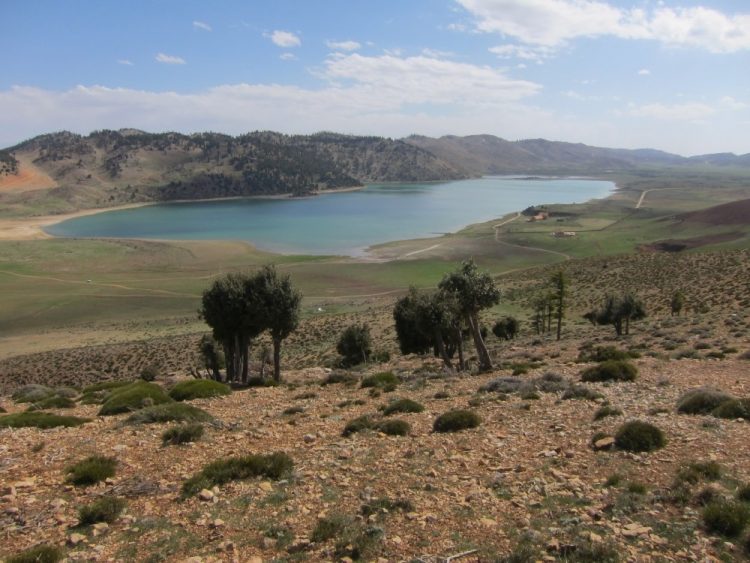Millennial-scale fluctuations in Saharan dust supply across the decline of the African Humid Period

The Lake Sidi Ali is located in the Moroccan Middle Atlas at 2.080 metres above sea-level. The position of the lake is in the North Saharan desert margin Photo: Sidi Ali dust research group
The researchers identified several millennial-scale phases of enhanced Saharan dust supplies during the transition of the former “green Sahara” to the present-day hyper-arid desert. The results were currently published in the famous geoscientific journal Quaternary Science Reviews.
Physical Geographers and Geoscientists from Leipzig, Manchester and Island Universities as well as a meteorologist from Leibniz Institute for Tropospheric Research in Leipzig and two archaeologists from Cologne and Rabat were involved in the international research project. By the investigation of recovered cores from Lake Sidi Ali in the Moroccan Middle Atlas, the researcher traced back Saharan dust phases until a time of 12.000 years before present.
”We suggest that increases in Northern Saharan dust supply do not solely indicate sub-regional to regional aridity in Mediterranean Northwest Africa but might reflect aridity at a trans-Saharan scale”, said Christoph Zielhofer.
The last 12.000 years of Saharan history comprises the end of the so-called African Humid Period. This transition toward the present-day hyper-arid desert took place during approximately 3000 to 7000 years before present following the current scientific debate. Before, the Saharan region was characterised by dry steppe and savannahs with elephants, lions and a large number of animals that occupy sub-Saharan biotopes under current climatic conditions.
The large grasslands were used by pastoral groups that leaved a lot of archaeological remains in the nowadays hostile landscape. “Our history of Saharan dust storms provides chronological information about past desiccation phases of the Sahara that must have severe consequences for former vegetation cover, wildlife and humans“, said Hans von Suchodoletz, dust researcher at the Institute of Geography in Leipzig.
The researcher discovered the surprising result that the end of the African Humid Period was not characterised by a single climatic transition toward a drier stage as formerly assumed but by multiple millennial-scale dust phases. The most prominent took place at approximately 10.200, 8.200 and 6.600 to 6.000 years before present. “The dust intervals at Lake Sidi Ali were interrupted by phases of low dust supply until at the latest at 4.700 years before present the atmospheric dust load was comparable to current climatic conditions”, said Christoph Zielhofer.
The results of the dust study were published (17th July 2017) in:
Zielhofer, C., von Suchodoletz, H., Fletcher, W.J., Dietze, E., Schneider, B., Schlegel, M., Schepanski, K., Weninger, B., Mikdad, A., Mischke, S., 2017.
“Millennial-scale fluctuations in Saharan dust supply across the decline of the African Humid Period” Quaternary Science Reviews 171, 119–135.
doi.org/10.1016/j.quascirev.2017.07.010
Principal Investigators:
Dr Christoph Zielhofer
zielhofer@uni-leipzig.de
Chair of Physical Geography, Leipzig University, Leipzig, Germany
phone: +49 341 97-32965
Dr William Fletcher
Department of Geography, School of Environment, Education and Development, University of Manchester, Manchester, United Kingdom
Dr Steffen Mischke
Faculty of Earth Sciences, University of Iceland, Reykjavík, Iceland
http://www.sciencedirect.com/science/article/pii/S0277379117301580
Media Contact
All latest news from the category: Earth Sciences
Earth Sciences (also referred to as Geosciences), which deals with basic issues surrounding our planet, plays a vital role in the area of energy and raw materials supply.
Earth Sciences comprises subjects such as geology, geography, geological informatics, paleontology, mineralogy, petrography, crystallography, geophysics, geodesy, glaciology, cartography, photogrammetry, meteorology and seismology, early-warning systems, earthquake research and polar research.
Newest articles

First-of-its-kind study uses remote sensing to monitor plastic debris in rivers and lakes
Remote sensing creates a cost-effective solution to monitoring plastic pollution. A first-of-its-kind study from researchers at the University of Minnesota Twin Cities shows how remote sensing can help monitor and…

Laser-based artificial neuron mimics nerve cell functions at lightning speed
With a processing speed a billion times faster than nature, chip-based laser neuron could help advance AI tasks such as pattern recognition and sequence prediction. Researchers have developed a laser-based…

Optimising the processing of plastic waste
Just one look in the yellow bin reveals a colourful jumble of different types of plastic. However, the purer and more uniform plastic waste is, the easier it is to…



